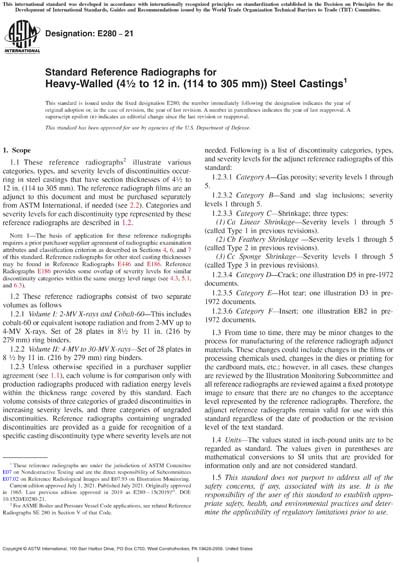Most recent
ASTM E280-21
Standard Reference Radiographs for Heavy-Walled (41 2
1.1These reference radiographs2 illustrate various categories, types, and severity levels of discontinuities occurring in steel castings that have section thicknesses of 41/2to 12 in. (114 to 305 mm). The reference radiograph films are an adjunct to this document and must be purchased separately from ASTM International, if needed (see 2.2). Categories and severity levels for each discontinuity type represented by these reference radiographs are described in 1.2.
Note 1:The basis of application for these reference radiographs requires a prior purchaser supplier agreement of radiographic examination attributes and classification criterion as described in Sections 4, 6, and 7 of this standard. Reference radiographs for other steel casting thicknesses may be found in Reference Radiographs E446 and E186. Reference Radiographs E186 provides some overlap of severity levels for similar discontinuity categories within the same energy level range (see 4.3, 5.1, and 6.3).
1.2These reference radiographs consist of two separate volumes as follows
1.2.1Volume I: 2-MV X-rays and Cobalt-60 - This includes cobalt-60 or equivalent isotope radiation and from 2-MV up to 4-MV X-rays. Set of 28 plates in 81/2by 11 in. (216 by 279 mm) ring binders.
1.2.2Volume II: 4-MV to 30-MV X-rays - Set of 28 plates in 8 1/2by 11 in. (216 by 279 mm) ring binders.
1.2.3Unless otherwise specified in a purchaser supplier agreement (see 1.1), each volume is for comparison only with production radiographs produced with radiation energy levels within the thickness range covered by this standard. Each volume consists of three categories of graded discontinuities in increasing severity levels, and three categories of ungraded discontinuities. Reference radiographs containing ungraded discontinuities are provided as a guide for recognition of a specific casting discontinuity type where severity levels are not needed. Following is a list of discontinuity categories, types, and severity levels for the adjunct reference radiographs of this standard:
1.2.3.1Category A - Gas porosity; severity levels 1 through 5.
1.2.3.2Category B - Sand and slag inclusions; severity levels 1 through 5.
1.2.3.3Category C - Shrinkage; three types:
(1)Ca Linear Shrinkage - Severity levels 1 through 5 (called Type 1 in previous revisions).
(2)Cb Feathery Shrinkage - Severity levels 1 through 5 (called Type 2 in previous revisions).
(3)Cc Sponge Shrinkage - Severity levels 1 through 5 (called Type 3 in previous revisions).
1.2.3.4Category D - Crack; one illustration D5 in pre-1972 documents.
1.2.3.5Category E - Hot tear; one illustration D3 in pre-1972 documents.
1.2.3.6Category F - Insert; one illustration EB2 in pre-1972 documents.
1.3From time to time, there may be minor changes to the process for manufacturing of the reference radiograph adjunct materials. These changes could include changes in the films or processing chemicals used, changes in the dies or printing for the cardboard mats, etc.; however, in all cases, these changes are reviewed by the Illustration Monitoring Subcommittee and all reference radiographs are reviewed against a fixed prototype image to ensure that there are no changes to the acceptance level represented by the reference radiographs. Therefore, the adjunct reference radiographs remain valid for use with this standard regardless of the date of production or the revision level of the text standard.
1.4Units - The values stated in inch-pound units are to be regarded as standard. The values given in parentheses are mathematical conversions to SI units that are provided for information only and are not considered standard.
1.5This standard does not purport to address all of the safety concerns, if any, associated with its use. It is the responsibility of the user of this standard to establish appropriate safety, health, and environmental practices and determine the applicability of regulatory limitations prior to use.
1.6This international standard was developed in accordance with internationally recognized principles on standardization established in the Decision on Principles for the Development of International Standards, Guides and Recommendations issued by the World Trade Organization Technical Barriers to Trade (TBT) Committee.
Content Provider
ASTM International [astm]






